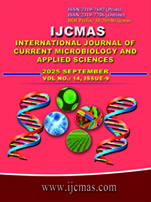


 National Academy of Agricultural Sciences (NAAS)
National Academy of Agricultural Sciences (NAAS)

|
PRINT ISSN : 2319-7692
Online ISSN : 2319-7706 Issues : 12 per year Publisher : Excellent Publishers Email : editorijcmas@gmail.com / submit@ijcmas.com Editor-in-chief: Dr.M.Prakash Index Copernicus ICV 2018: 95.39 NAAS RATING 2020: 5.38 |
The emergence of methicillin-susceptible Staphylococcus aureus (MSSA), particularly the MSSA CC398 spa-type t571 clone, associated with livestock, represents a public health concern due to its zoonotic potential and ability to cause severe infections in humans. This study, conducted in Côte d’Ivoire between January 2022 and October 2023, is the first investigation aimed at assessing the prevalence, genetic characteristics, and antimicrobial resistance profiles of MSSA strains isolated from pigs and exposed workers. A total of 1,176 pigs and 50 workers were sampled across 15 farms in two regions (autonomous district of Abidjan and Sassandra-Marahoué district). Nasal swabs (from humans and pigs) were collected and subjected to microbiological anlysis for S. aureus research. The isolated strains were phenotypically identified and submitted to antibiotic susceptibility testing using the Kirby-Bauer method. They were also submitted to molecular characterization targeting the nuc, spa and lukS-lukF genes, as well as tetracycline resistance genes (tet(K), tet(L), tet(M), tet(O)). The results show that nasal carriage prevalence of MSSA was 12.2% in pigs and 62.7% in workers, highlighting a significant occupational risk. Among pig categories, carriage was significantly higher in weaned piglets (19.2%). Molecular analysis revealed a strong predominance of the CC398 clonal complex, particularly spa-type t571, in both pig (97.2%) and human (100%) isolates, suggesting probable zoonotic transmission. High rates of tetracycline resistance were observed in the isolates (68% from those of pigs, 83.8% from those of humans), primarily linked to the presence of tet(K)and tet(L) genes. The absence of the lukS-lukF-PV gene (encoding the PVL toxin) in all isolates likely reflects their animal origin. Antibiotic susceptibility testing revealed resistance phenotypes to other antibiotics such as penicillin, ampicillin, and ciprofloxacin, demonstrating the multidrug resistance of these clones. Additionally, the detection of the MSSA CC398 spa-type t1250 clone and the identification of a novel spa-type (t6608) in the pig population underscored the genetic diversity of circulating strains. This study reports, for the first time in Côte d’Ivoire, the emergence of the MSSA CC398 spa-type t571 clone in pig farms. Antibiotics may have favored the selection and dissemination of this clone. Further molecular analyses are needed to more precisely assess the genetic relatedness between pig and human isolates.
Aarestrup, F.M., Wegener, H.C., Collignon, P., 2008. Resistance in bacteria of the food chain: epidemiology and control strategies. Expert review of anti-infective therapy, 6(5), 733–750. https://doi.org/10.1586/14787210.6.5.733
Argudín, M.A., Tenhagen, B.A., Fetsch, A., Sachsenröder, J., Käsbohrer, A., Schroeter, A., Hammerl, J.A., Hertwig, S., Helmuth, R., Bräunig, J., Mendoza, M.C., Appel, B., Rodicio, M.R., Guerra, B., 2011. Virulence and resistance determinants of German Staphylococcus aureus ST398 isolates from nonhuman sources. Applied and environmental microbiology, 77(9), 3052–3060. https://doi.org/10.1128/AEM.02260-10
Bergey, D.H., Sneath, P.H.A., Holt, J.G. 1986. Bergey’s manual of systematic bacteriology. Vol. 2. Williams & Wilkins.
Brakstad, O.G., Aasbakk, K., Maeland, J.A.1992. Detection of Staphylococcus aureus by polymerase chain reaction amplification of the nuc gene. Journal of clinical microbiology, 30(7), 1654–1660. https://doi.org/10.1128/jcm.30.7.1654-1660.1992
Chopra, I., Roberts, M. 2001. Tetracycline antibiotics: Mode of action, applications, molecular biology, and epidemiology of bacterial resistance. Microbiology and Molecular Biology Reviews, 65(2), 232–260. https://doi.org/10.1128/MMBR.65.2.232-260.2001
CLSI, 2020. Performance Standards for Antimicrobial Disk and Dilution Susceptibility Tests for Bacteria Isolated from animals. 5th ed. CLSI supplement VET01S.
Cuny, C., Wieler, L.H., Witte, W., 2015. Livestock-associated MRSA: The impact on humans. Antibiotics, 4(4), 521–543. https://doi.org/10.3390/antibiotics4040521
de Neeling, A.J., van den Broek, M.J., Spalburg, E.C., van Santen-Verheuvel, M.G., Dam-Deisz, W.D., Boshuizen, H.C., van de Giessen, A.W., van Duijkeren, E., Huijsdens, X.W., 2007. High prevalence of methicillin resistant Staphylococcus aureus in pigs. Veterinary microbiology, 122(3-4), 366–372. https://doi.org/10.1016/j.vetmic.2007.01.027
Dweba, C.C., Zishiri, O.T., El Zowalaty, M.E., 2019. Isolation and Molecular Identification of Virulence, Antimicrobial and Heavy Metal Resistance Genes in Livestock-Associated Methicillin-Resistant Staphylococcus aureus. Pathogens (Basel, Switzerland), 8(2), 79. https://doi.org/10.3390/pathogens8020079
European Food Safety Authority (EFSA), 2009. Scientific opinion of the panel on biological hazards on a request from the European Commission on assessment of the public health significance of meticillin resistant Staphylococcus aureus (MRSA) in animals and foods. EFSA J. 993, 1–73.
Fall, C., Seck, A., Richard, V., Ndour, M., Sembene, M., Laurent, F., Breurec, S., 2012. Epidemiology of Staphylococcus aureus in pigs and farmers in the largest farm in Dakar, Senegal. Foodborne pathogens and disease, 9(10), 962–965. https://doi.org/10.1089/fpd.2012.1197
Gómez, P., Lozano, C., Camacho, M.C., Lima-Barbero, J.F., Hernández, J.M., Zarazaga, M., Höfle, Ú., Torres, C., 2016. Detection of MRSA ST3061-t843-mecC and ST398-t011-mecA in white stork nestlings exposed to human residues. The Journal of antimicrobial chemotherapy, 71(1), 53–57. https://doi.org/10.1093/jac/dkv314
Guay, G.G., Khan, S.A., Rothstein, D.M., 1993. The tet(K) gene of plasmid pT181 of Staphylococcus aureus encodes an efflux protein that contains 14 transmembrane helices. Plasmid, 30(2), 163–166. https://doi.org/10.1006/plas.1993.1045
Hasman, H., Moodley, A., Guardabassi, L., Stegger, M., Skov, R.L., Aarestrup, F.M., 2010. Spa type distribution in Staphylococcus aureus originating from pigs, cattle and poultry. Veterinary microbiology, 141(3-4), 326–331. https://doi.org/10.1016/j.vetmic.2009.09.025
Holmes, A., Ganner, M., McGuane, S., Pitt, T.L., Cookson, B.D., Kearns, A.M., 2005. Staphylococcus aureus isolates carrying Panton-Valentine leucocidin genes in England and Wales: frequency, characterization, and association with clinical disease. Journal of clinical microbiology, 43(5), 2384–2390. https://doi.org/10.1128/JCM.43.5.2384-2390.2005
Igbinosa, E.O., Beshiru, A., Akporehe, L.U., Oviasogie, F.E., Igbinosa, O.O., 2016. Prevalence of Methicillin-Resistant Staphylococcus aureus and Other Staphylococcus Species in Raw Meat Samples Intended for Human Consumption in Benin City, Nigeria: Implications for Public Health. International journal of environmental research and public health, 13(10), 949. https://doi.org/10.3390/ijerph13100949
Jones, C.H., Tuckman, M., Howe, A.Y. M., Orlowski, M., Mullen, S., Chan, K., Bradford, P. A., 2006. Diagnostic PCR analysis of the occurrence of methicillin and tetracycline resistance genes among Staphylococcus aureus isolates from phase 3 clinical trials of tigecycline for complicated skin and skin structure infections. Antimicrobial Agents and Chemotherapy, 50(2), 505–510. https://doi.org/10.1128/AAC.50.2.505-510.2006
Kadlec, K., Fessler, A. T., Hauschild, T., Schwarz, S., 2012. Novel and uncommon antimicrobial resistance genes in livestock-associated methicillin-resistant Staphylococcus aureus. Clinical microbiology and infection : the official publication of the European Society of Clinical Microbiology and Infectious Diseases, 18(8),745–755. https://doi.org/10.1111/j.1469-0691.2012.03842.x
Katakweba, A.S., Muhairwa, A.P., Espinosa-Gongora, C., Guardabassi, L., Mtambo, M.M., Olsen, J.E., 2016. spa typing and antimicrobial resistance of Staphylococcus aureus from healthy humans, pigs and dogs in Tanzania. Journal of Infection in Developing Countries, 10(2), 143–148. https://doi.org/10.3855/jidc.6790
Khanna, T., Friendship, R., Dewey, C., Weese, J.S., 2008. Methicillin resistant Staphylococcus aureus colonization in pigs and pig farmers. Veterinary microbiology, 128(3-4), 298–303. https://doi.org/10.1016/j.vetmic.2007.10.006
Köck, R., Harlizius, J., Bressan, N., Laerberg, R., Wieler, L.H., Witte, W., Deurenberg, R. H., Voss, A., Becker, K., Friedrich, A.W., 2009. Prevalence and molecular characteristics of methicillin-resistant Staphylococcus aureus (MRSA) among pigs on German farms and import of livestock-related MRSA into hospitals. European journal of clinical microbiology & infectious diseases : official publication of the European Society of Clinical Microbiology, 28(11), 1375–1382. https://doi.org/10.1007/s10096-009-0795-4
LeBlanc, D.J., Lee, L.N., Titmas, B.M., Smith, C.J., Tenover, F.C., 1988. Nucleotide sequence analysis of tetracycline resistance gene tetO from Streptococcus mutans DL5. Journal of bacteriology, 170(8), 3618–3626. https://doi.org/10.1128/jb.170.8.3618-3626.1988
Lina, G., Piémont, Y., Godail-Gamot, F., Bes, M., Peter, M.O., Gauduchon, V., Vandenesch, F., Etienne, J., 1999. Involvement of Panton-Valentine leukocidin-producing Staphylococcus aureus in primary skin infections and pneumonia. Clinical Infectious Diseases, 29(5), 1128–1132. https://doi.org/10.1086/313461
Lozano, C., Gharsa, H., Ben Slama, K., Zarazaga, M., Torres, C., 2016. Staphylococcus aureus in Animals and Food : Methicillin Resistance, Prevalence and Population Structure. A Review in the African Continent. Microorganisms, 4(1), 12. https://doi.org/10.3390/microorganisms4010012
Maes, N., Magdalena, J., Rottiers, S., De Gheldre, Y., Struelens, M.J., 2002. Evaluation of a triplex PCR assay to discriminate Staphylococcus aureus from coagulase-negative Staphylococci and determine methicillin resistance from blood cultures. Journal of clinical microbiology, 40(4), 1514–1517. https://doi.org/10.1128/JCM.40.4.1514-1517.2002
Mathema, B., Mediavilla, J., Kreiswirth, B.N., 2008. Sequence analysis of the variable number tandem repeat in Staphylococcus aureus protein A gene: spa typing. Methods in molecular biology (Clifton, N.J.), 431, 285–305. https://doi.org/10.1007/978-1-60327-032-8_22
Ministère des ressources animales et halieutiques (MIRAH), 2018. Statistiques sur les ressources animales et halieutiques
Momoh, A.H., Kwaga, J.K.P., Bello, M., Sackey, A.K.B., Larsen, A.R., 2018. Antibiotic resistance and molecular characteristics of Staphylococcus aureus isolated from backyard-raised pigs and pig workers. Tropical animal health and production, 50(7), 1565–1571.
https://doi.org/10.1007/s11250-018-1596-5
Nesin, M., Svec, P., Lupski, J. R., Godson, G. N., Kreiswirth, B., Kornblum, J., Projan, S.J., 1990. Cloning and nucleotide sequence of a chromosomally encoded tetracycline resistance determinant, tetA(M), from a pathogenic, methicillin-resistant strain of Staphylococcus aureus. Antimicrobial agents and chemotherapy, 34(11), 2273–2276. https://doi.org/10.1128/AAC.34.11.2273
Okunlola I., Ayandele A., 2015. Prevalence and antimicrobial susceptibility of methicillin-resistant Staphylococcus aureus (MRSA) among pigs in selected farms in Ilora, South Western Nigeria. European Journal of Experimental Biology 2015;5:50–6.
Oliveira, D. C., de Lencastre, H., 2002. Multiplex PCR strategy for rapid identification of structural types and variants of the mec element in methicillin-resistant Staphylococcus aureus. Antimicrobial agents and chemotherapy, 46(7), 2155–2161. https://doi.org/10.1128/AAC.46.7.2155-2161.2002
Platteeuw, C., Michiels, F., Joos, H., Seurinck, J., de Vos, W.M., 1995. Characterization and heterologous expression of the tetL gene and identification of iso-ISS1 elements from Enterococcus faecalis plasmid pJH1. Gene, 160(1), 89–93. https://doi.org/10.1016/0378-1119(95)00208-n
Price, L.B., Stegger, M., Hasman, H., Aziz, M., Larsen, J., Andersen, P.S., Pearson, T., Waters, A.E., Foster, J.T., Schupp, J., Gillece, J., Driebe, E., Liu, C.M., Springer, B., Zdovc, I., Battisti, A., Franco, A., ?mudzki, J., Schwarz, S., Aarestrup, F.M., 2012. Staphylococcus aureus CC398: Host adaptation and emergence of methicillin resistance in livestock. mBio, 3(1), e00305-11. https://doi.org/10.1128/mBio.00305-11
Rasigade, J.P., Laurent, F., Hubert, P., Vandenesch, F., Etienne, J., 2010. Lethal necrotizing pneumonia caused by an ST398 Staphylococcus aureus strain. Emerging infectious diseases, 16(8), 1330. https://doi.org/10.3201/eid1608.100317
Roberts, M.C., 2005. Update on acquired tetracycline resistance genes. FEMS Microbiology Letters, 245(2), 195–203. https://doi.org/10.1016/j.femsle.2005.02.034
Samutela, M.T., Kwenda, G., Simulundu, E., Nkhoma, P., Higashi, H., Frey, A., Bates, M., Hang’ombe, B.M., 2021. Pigs as a potential source of emerging livestock-associated Staphylococcus aureus in Africa: A systematic review. International Journal of Infectious Diseases, 109, 38–49. https://doi.org/10.1016/j.ijid.2021.06.023
Schaumburg, F., Pauly, M., Anoh, E., Mossoun, A., Wiersma, L., Schubert, G., Flammen, A., Alabi, A. S., Muyembe-Tamfum, J.J., Grobusch, M.P., Karhemere, S., Akoua-Koffi, C., Couacy-Hymann, E., Kremsner, P.G., Mellmann, A., Becker, K., Leendertz, F.H., Peters, G., 2015. Staphylococcus aureus complex from animals and humans in three remote African regions. Clinical microbiology and infection : the official publication of the European Society of Clinical Microbiology and Infectious Diseases, 21(4), 345.e1–345.e3458. https://doi.org/10.1016/j.cmi.2014.12.001
Schwarz, S., Kehrenberg, C., Doublet, B., Cloeckaert, A., 2001. Molecular basis of bacterial resistance to chloramphenicol and florfenicol. FEMS Microbiology Reviews, 25(5), 519–542. https://doi.org/10.1111/j.1574-6976.2001.tb00591.x
Trzcinski, K., Cooper, B.S., Hryniewicz, W., Dowson, C.G., 2000. Expression of resistance to tetracyclines in strains of methicillin-resistant Staphylococcus aureus. Journal of Antimicrobial Chemotherapy, 45(6), 763–770. https://doi.org/10.1093/jac/45.6.763
Uhlemann, A.C., Porcella, S.F., Trivedi, S., Sullivan, S.B., Hafer, C., Kennedy, A.D., Barbian, K.D., McCarthy, A.J., Street, C., Hirschberg, D.L., Lipkin, W.I., Lindsay, J.A., DeLeo, F.R., Lowy, F.D., 2012. Identification of a highly transmissible animal-independent Staphylococcus aureus ST398 clone with distinct genomic and cell adhesion properties. mBio, 3(2), e00027-12. https://doi.org/10.1128/mBio.00027-12
van Cleef, B.A., Monnet, D.L., Voss, A., Krziwanek, K., Allerberger, F., Struelens, M., Zemlickova, H., Skov, R.L., Vuopio-Varkila, J., Cuny, C., Friedrich, A.W., Spiliopoulou, I., Pászti, J., Hardardottir, H., Rossney, A., Pan, A., Pantosti, A., Borg, M., Grundmann, H., Mueller-Premru, M., Kluytmans, J.A., 2011. Livestock-associated methicillin-resistant Staphylococcus aureus in humans, Europe. Emerging infectious diseases, 17(3), 502–505. https://doi.org/10.3201/eid1703.101036
van Duijkeren, E., Jansen, M.D., Flemming, S.C., de Neeling, H., Wagenaar, J.A., Schoormans, A.H., van Nes, A., Fluit, A.C., 2007. Methicillin-resistant Staphylococcus aureus in pigs with exudative epidermitis. Emerging infectious diseases, 13(9), 1408–1410. https://doi.org/10.3201/eid1309.061268
Voss, A., Loeffen, F., Bakker, J., Klaassen, C., Wulf, M., 2005. Methicillin-resistant Staphylococcus aureus in pig farming. Emerging infectious diseases, 11(12), 1965–1966. https://doi.org/10.3201/eid1112.050428
WHO, (1991). Manuel d'e?pide?miologie pour la gestion de la sante? au niveau du district, Jouve (Eds.), 186 p.
Zarazaga, M., Gómez, P., Ceballos, S.,Torres, C., 2010. Molecular epidemiology of Staphylococcus aureus lineages in the animal-human interface. In Staphylococcus aureus (pp. 189–203). Academic Press. https://doi.org/10.1016/B978-0-12-809671-0.00010-3 |
 |
 |
 |
 |